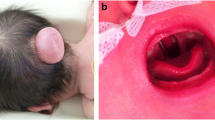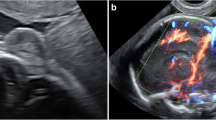Abstract
Atretic cephaloceles refer to the congenital herniation of meningeal and vestigial tissues such as arachnoid, glial or neural rests. These small, skin covered subscalp lesions usually appear within a few centimetres of the lambda and nearly half of them have a parietal situation, the remaining half have occipital, parieto-occipital, frontal, asterion, and sincipital locations. Atretic cephaloceles can be isolated or associated with congenital syndromes, agenesis of corpus callosum, grey matter heterotopias, ventriculomegaly, mental retardation, developmental delay, epilepsy, spasticity, speech difficulty, strabismus, optic nerve atrophy, microphthalmia, enophthalmos, cleft palate, hypertelorism, congenital cardiac and vascular defects, renal agenesis, hearing problems, congenital lobar emphysema, and muscular anomalies. This case report describes a newborn which has been diagnosed with atretic occipital cephalocele prenatally and also bilateral cochlear hypoplasia postnatally.


Similar content being viewed by others
References
Şengöz A, Kaya M, Yildirim CH, Tasdemiroglu E. Atretic cephalocele in adults. Acta Neurochir (Wien). 2011;153(11):2275–7.
Bick DS, Brockland JJ, Scott AR. A scalp lesion with intracranial extension. Atretic cephalocele. JAMA Otolaryngol Head Neck Surg. 2015;141(3):289–90.
Demir MK, Çolak A, Ekşi MŞ, Özcan-Ekşi EE, Akakın A, Yılmaz B. Atretic cephaloceles: a comprehensive analysis of historical cohort. Childs Nerv Syst. 2016;32(12):2327–37.
Hsu SW, Chaloupka JC. Atretic parietal cephalocele associated with sinus pericranii: embryological consideration. Brain Dev. 2012;34(4):325–8.
Fukuyama M, Tanese K, Yasuda F, Hayashi Y, Tanikawa A. Two cases of atretic cephalocele, and histological evaluation of skin appendages in the surrounding skin. Clin Exp Dermatol. 2016;41(1):48–52.
Carvalho DR, Giuliani LR, Simão GN, Santos AC, Pina-Neto JM. Autosomal dominant atretic cephalocele with phenotype variability: report of a Brazilian family with six affected in four generations. Am J Med Genet A. 2006;140(13):1458–62.
Wong SL, Law HL, Tan S. Atretic cephalocele—an uncommon cause of cystic scalp mass. Malays J Med Sci. 2010;17(3):61–3.
Santos SF, Ramos H, Irañeta A, Conceição C. Atretic parietal encephalocoele. BMJ Case Rep. 2016. https://doi.org/10.1136/bcr-2016-215812.
Güzel A, Tatli M, Er U, Bavbek M. Atretic parietal cephalocele. Pediatr Neurosurg. 2007;43(1):72–3.
Steven JW, Donnenfeld AE. Syndromes identified in fetuses with prenatally diagnosed cephaloceles. Prenat Diagn. 1994;14:839–43.
Fox NS, Monteagudo A, Kuller JA, Craigo S, Norton ME. Mild fetal ventriculomegaly: diagnosis, evaluation, and management. Am J Obstet Gynecol. 2018;219(1):B2–9.
Wyldes M, Watkinson M. Isolated mild fetal ventriculomegaly. Arch Dis Child Fetal Neonatal Ed. 2004;89:F9–13.
Leykamm S, Wessling B, Mühlenbruch G. Atretic cephalocele and associated anomalies in a newborn child. Clin Neuroradiol. 2013;23(1):37–40.
Siverino RO, Guarrera V, Attinà G, Chiaramonte R, Milone P, Chiaramonte I. Parietal atretic cephalocele: associated cerebral anomalies identified by CT and MR imaging. Neuroradiol J. 2015;28(2):217–21.
Morioka T, Hashiguchi K, Samura K, Yoshida F, Miyagi Y, Yoshiura T, Suzuki SO, Sasaki T. Detailed anatomy of intracranial venous anomalies associated with atretic parietal cephaloceles revealed by high-resolution 3D-CISS and high-field T2-weighted reversed MR images. Childs Nerv Syst. 2009;25(3):309–15.
Author information
Authors and Affiliations
Corresponding author
Ethics declarations
Conflict of interest
The authors declare that they have no conflict of interest.
Informed Consent
Informed consent was obtained from all individual participants included in the study.
Additional information
Publisher's Note
Springer Nature remains neutral with regard to jurisdictional claims in published maps and institutional affiliations.
Rights and permissions
About this article
Cite this article
Kunt İşgüder, Ç., Koşar Can, Ö., Kanat Pektaş, M. et al. Prenatal Diagnosis of Atretic Occipital Cephalocele: A Case Report. J. Fetal Med. 6, 133–137 (2019). https://doi.org/10.1007/s40556-019-00211-z
Received:
Revised:
Accepted:
Published:
Issue Date:
DOI: https://doi.org/10.1007/s40556-019-00211-z




